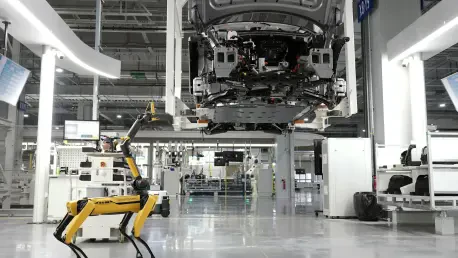In a market where industrial automation stocks are capturing significant investor attention, THK, a leading precision manufacturing and motion control company, has emerged as a standout performer with a remarkable 78% surge in its stock price over the past year, complemented by a solid 10% gain year-to-date. This dramatic rally has sparked intense debate among analysts and investors alike about whether such momentum can persist or if the stock has climbed too far, too fast. With the automation sector riding high on factory investment trends, THK’s performance reflects broader industry optimism. However, as global economic challenges loom and valuation concerns surface, there is growing scrutiny over whether the current price fully accounts for future growth potential. This analysis aims to dissect the factors driving THK’s ascent and evaluate if this rally represents a sustainable opportunity or a signal for caution in an increasingly complex market environment.
Sector Dynamics and Market Performance
Automation Boom Fueling Growth
The industrial automation sector has been a hotbed of investor interest, driven by a global push toward enhanced factory efficiency and technological innovation, positioning companies like THK at the forefront of this transformative wave. THK specializes in precision components critical to automation systems, and this alignment with industry trends has significantly boosted its stock performance over recent months. A 78% rally over the past year underscores strong market confidence in the company’s ability to capitalize on increased capital spending by manufacturers worldwide. Yet, while short-term metrics show stability with a modest 0.6% gain in the last week and flat performance over the past 30 days, the broader question remains whether this momentum is rooted in sustainable fundamentals or merely speculative enthusiasm. The sector’s tailwinds are undeniable, but they must be weighed against potential overoptimism that could leave stocks vulnerable to corrections if growth expectations falter.
Economic Headwinds Casting Shadows
Despite the favorable sector dynamics, global economic uncertainties present a counterbalance to the optimism surrounding THK and its peers in the automation space. Rising interest rates, geopolitical tensions, and supply chain disruptions continue to challenge industrial companies, potentially dampening the pace of factory investments that have fueled THK’s growth. These macroeconomic pressures could constrain demand for precision components in the near term, even as long-term trends remain positive. Investors must consider how these external factors might impact earnings projections, especially given that much of the current stock price surge appears to hinge on expectations of robust future growth. While the automation boom offers a promising backdrop, the interplay of these broader economic challenges suggests that sustained upward movement in THK’s stock may face hurdles, prompting a closer look at whether the current valuation aligns with realistic outcomes in a tougher global environment.
Valuation Insights and Investor Considerations
Assessing Intrinsic Value Through DCF Analysis
A deeper dive into THK’s valuation reveals a nuanced picture that tempers the excitement surrounding its recent stock rally, with a Discounted Cash Flow (DCF) analysis estimating the intrinsic value at ¥3,746 per share, indicating an 8.1% premium in the current trading price. This suggests that the stock is priced close to its fair value, leaning slightly toward overvaluation based on projected cash flows. Recent twelve-month free cash flow figures stand at ¥4.02 billion, with analyst forecasts anticipating a significant rise to ¥26.04 billion by 2029, reflecting confidence in long-term growth. However, the lack of undervaluation signals—scoring 0 out of 6 on traditional metrics—reinforces the view that much of this growth may already be baked into the stock price. For investors, this data points to a scenario where the potential for outsized gains appears limited unless unexpected catalysts emerge to drive performance beyond current expectations.
Balancing Opportunity and Risk
While THK benefits from strong sector tailwinds, the valuation metrics urge a cautious approach, as the stock does not present a clear bargain at its current level, prompting investors to weigh the risks of a potential correction against the possibility of further upside. The absence of undervaluation indicators, combined with a DCF analysis suggesting a slight premium, highlights the importance of timing and market conditions in decision-making. Investors should also monitor global economic developments that could impact industrial spending, as these factors might alter the growth trajectory baked into current forecasts. Rather than a definitive buy or sell signal, the analysis underscores the need for vigilance, encouraging the use of tools like detailed valuation models to track changes over time. As the automation sector continues to evolve, balancing enthusiasm for THK’s market position with a grounded assessment of its price will be critical for informed investment strategies.
Wrapping Up: Strategic Takeaways
Reflecting on THK’s journey, the stock’s impressive 78% rally over the past year stands as a testament to the strength of the industrial automation sector, yet valuation analyses paint a more restrained picture of its immediate potential. The DCF insights and lack of undervaluation signals hint at a stock priced near or slightly above its intrinsic worth, urging a measured perspective among market participants. Moving forward, investors would be wise to keep a close eye on evolving economic conditions and sector-specific developments that could shift the narrative. Leveraging comprehensive valuation tools to monitor price adjustments over time could provide clarity on entry or exit points. Additionally, staying attuned to factory investment trends and global demand patterns will be essential in gauging whether THK can defy valuation concerns and sustain its upward trajectory. This balanced approach ensures that decisions are grounded in data, offering a pathway to navigate the opportunities and risks that define THK’s market standing.









